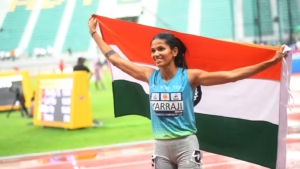The 2026 Australian Open Asia-Pacific Wildcard Playoff (AWP), scheduled from November 24–29 in Chengdu, remains one of the most consequential tournaments for players across the region.
For Asian and Asia-Pacific athletes outside Australia, it serves as the clearest gateway into the first Grand Slam of the season. For Indian players fighting for form, ranking momentum, and financial security the Chengdu playoff offers a rare, direct chance to enter the Australian Open main draw without navigating the demanding global qualifying route.
The structure is straightforward but unforgiving:
- 16-player main draw
- 8 direct acceptances, determined purely by ranking
- 4 wildcards
- 4 qualifiers, drawn from an 8-player Q field
The format rewards match-tight players accustomed to high-intensity hard-court tennis, while punishing those without recent form or surface-specific preparation. And while the entry list appears strong this year, late withdrawals common across previous editions could reshape the draw before the first ball is struck.

Direct Acceptances: A Stacked Field Led by East Asia
Eight players have secured direct entry into the main draw, reflecting regional depth and an increasingly competitive Asia-Pacific tennis landscape:
- Bu Yunchaokete (CHN) – 114
- Coleman Wong (HKG) – 152
- Sho Shimabukuro (JPN) – 157
- Yosuke Watanuki (JPN) – 170
- James Trotter (JPN) – 260
- Fajing Sun (CHN) – 263
- Sumit Nagal (IND) – 276
- Beibit Zhukayev (KAZ) – 282
The top of the acceptance list is dominated by Chinese, Hong Kong, and Japanese contenders, all of whom enter the event with strong Challenger-level momentum. India’s lone direct entrant, Sumit Nagal, finds himself in a challenging but not insurmountable position. After a demanding 2025 season marked by inconsistent results and limited hard-court exposure, he now seeks to reset in Chengdu.
For Nagal, the AWP is not just another tournament; it is an opportunity to salvage a difficult season and potentially regain entry into a Slam he has previously performed well at. After the Australian Open earlier this year, he has barely played outdoor hard courts, spending most of the season on clay surfaces. His ranking dipped to 276, and the lack of continuity on the surface most relevant to the AWP has cost him valuable momentum.
Read Articles Without Ads On Your IndiaSportsHub App. Download Now And Stay Updated
Still, Nagal has shown time and again that he thrives under pressure. His ability to elevate on big stages, particularly the Australian Open, where he has previously reached the second round, could once again make the difference. In a compact 16-player draw, only four wins are needed to seal a main-draw wildcard. For a player of Nagal’s experience, this remains within reach.
Indian Challengers in Qualifying: Mukund and Rawat Aim for a Late Entry
Mukund Sasikumar (ALT 7) and Sidharth Rawat (ALT 10) enter the AWP as Qualifying Alternates for now, awaiting potential withdrawals. Mukund has struggled through 2025, especially in closing out ITF M15 events in Asia, where he failed to secure titles despite several deep runs. His consistency and confidence have fluctuated, leaving him outside the automatic Q entry spots.
On the other hand, Rawat’s 2025 season has quietly stabilized. He captured his first M15 title since 2022 and has played with more tactical discipline. Should withdrawals open up spots, both players could enter the qualifying draw, though their paths remain uncertain.
Women’s Singles: Opportunities for Sahaja and Shrivalli
In the Women’s Singles field, India’s hopes rest on Sahaja Yamalapalli (ALT 1) and Shrivalli Rashmika Bhamidipaty (ALT 8), both currently listed as Q Alternates. Their qualification depends on draw movement, but their recent form makes them compelling contenders should they gain entry. Crucially, both players are representing India at the Billie Jean King Cup this week. Positive results there could give them the momentum needed to carry confidence into Chengdu. Sahaja’s aggressive baseline game and Shrivalli’s improved court craft make both capable of upsetting higher-ranked opponents in a condensed format.
Men’s Doubles: India’s Strongest Shot at Success
India’s most promising chances, however, lie in the Men’s Doubles draw, where multiple Indian pairs feature prominently:
- Poonacha / Isaro – 2nd seeds
- Ramanathan / Jeevan – seeded combination
- Rawat / Goyal – last direct entrants
This is a 12-team draw where only the winners claim the Australian Open main-draw wildcard. Indian doubles tennis traditionally thrives in such scenarios, and this year’s pairings bring both experience and synergy. The standout contenders are Niki Kaliyanda Poonacha and Pruchya Isaro, a cross-national pairing that has been on an excellent run at the Challenger level. Their chemistry, combined with strong serving patterns and consistent hard-court success, positions them as genuine title contenders.
Ramanathan and Jeevan, both experienced campaigners, bring depth and tactical versatility. While they have switched partnerships often in 2025, their skill sets complement each other well when aligned.
Read Articles Without Ads On Your IndiaSportsHub App. Download Now And Stay Updated
Given the unpredictability of withdrawals, the final complexion of the draw may shift. But key Indian protagonists remain clear:
- Men’s Singles: Sumit Nagal, looking to translate past Slam experience into a reset opportunity.
- Women’s Singles: Sahaja and Shrivalli, whose BJKC participation could spark a surge in confidence.
- Men’s Doubles: Poonacha/Isaro and Ramanathan/Jeevan, both capable of title runs.
For Indian tennis, the Chengdu playoff represents more than a wildcard. It is a platform to pivot momentum heading into the 2026 season. With hard courts, high stakes, and limited slots, the AWP demands precision over weeks of preparation.
As always, hope remains high that India’s contingent can rise to the occasion and convert this crucial window into a coveted spot in the Australian Open 2026 Main Draw.
How useful was this post?
Click on a star to rate it!
Average rating 4.1 / 5. Vote count: 17
No votes so far! Be the first to rate this post.






